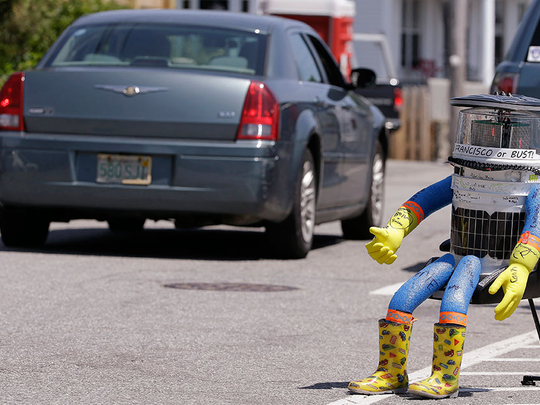
So who killed hitchBOT? The friendly hitchhiking robot made it across Germany, the Netherlands and Canada with nary a scratch, its treks followed by children and technology enthusiasts worldwide. Alas, the US proved less welcoming: Recently, hitchBOT was wrecked — in the City of Brotherly Love.
I hope we solve the crime. I’d like to ask whoever did it why.
HitchBOT was designed by Canadian researchers to investigate whether a robot on its own could survive in a world of humans. So they created a sociable machine that could talk to passers-by, asking for rides to its next destination. Here’s the Associated Press, summarising the experiment:
“The kid-size robot set out to travel cross-country after successfully hitchhiking across Canada in 26 days last year and parts of Europe. It’s immobile on its own, relying on the kindness of strangers. Those who picked it up often passed it to other travellers or left it where others might notice it.”
Kind strangers carried hitchBOT to a wedding and a comic book convention.
With its bright blue limbs and squarish head inside a clear canopy, hitchBOT looked about as unthreatening as a robot can look. It was designed to be unfailingly polite in its requests for help and could carry on a limited conversation. Europeans and Canadians were cooperative. Then hitchBOT’s creators decided to try the same experiment in the US.
The journey started in Massachusetts, and, at first, things went according to plan. After a period in Marblehead, hitchBOT was carried to Boston. The robot’s Twitter feed features photographs on the Duck Tour and at the Public Garden. At Fenway Park, fans dressed hitchBOT in a Red Sox jersey. In New York, it was photographed in Times Square.
After that, alas, hitchBOT’s fortunes turned sour. On Friday, a motorist tweeted, “I just picked up a hitchhiking robot!! This night has gotten really weird.” The robot ended up in Philadelphia, where a person or persons unknown smashed its canopy, tore its arms from their sockets and left the wrecked robot in the street.
We’ll probably never know who destroyed hitchBOT, which is a shame, because it would be interesting to ask the perpetrators why they did it. Was the attack simply the work of teenagers who, had the robot not been available, would have vandalised something else? Or was some special anti-robot animus at work? If we’re going to play detective, we should look at the evidence.
Researchers have tried various methods over the years to measure public acceptance of robots in various roles. Attitudes toward them vary, and are probably influenced by images in science fiction. A 2012 study for the European Commission found that most Europeans surveyed had favourable opinions of robots in general, but a strong majority nevertheless opposed their use in the care of children, the elderly or the disabled. Asked about robots in their own lives, 48 per cent said that they would work beside a robot, but few were willing to have a robot perform surgery on them. (Interestingly, respondents also overwhelmingly said they would not want robots to walk their dogs.)
There are important cultural differences in views about robots. For example, a 2008 study of college students in Japan, Korea, and the US found levels of acceptance of robots as communication partners (just what it sounds like) highest in Japan and lowest in the US. But acceptance of robots in the workplace was highest in the US.
What about familiarity with technology? A 2012 study by James E. Katz and Daniel Halpern found that although general competence with the Internet was not a predictor of attitudes toward robots, particular online experiences — for instance, membership in a community that uses avatars for interaction — suggested a more positive attitude.
So whoever killed hitchBOT probably wasn’t a member of Second Life.
But it’s likely that whoever did was prone to violence toward people, too. Recent research indicates that our brains respond to images of love or violence toward humans and robots in similar ways. Volunteers viewed images of a woman wearing green and separate images of a green robot dinosaur. Functional magnetic resonance imaging of the subjects’ brains showed similar activity in the limbic regions as they watched the woman and the robot being treated affectionately or cruelly, with the important exception that as the cruelty intensified, images of physical violence against the woman evoked more powerful responses than those of physical violence against the robot.
The researchers professed surprise at the degree of empathy toward robots: “Even though we assumed that the robot stimuli would trigger emotional processing, we expected these processes to be considerably weaker than for human stimuli,” one said.
There’s also anecdotal evidence that many people feel empathy toward robots — at least the cute ones. Earlier this year, Boston Dynamics, a company owned by Google, posted a YouTube video of its employees kicking its new 160-pound robotic dog, Spot. The company’s intention was to demonstrate how tough and steady Spot is. A firestorm of social media criticism followed, along with several satirical videos protesting a rising tide of violence against robot dogs.
We still don’t know whether the wrecking of hitchBOT was simple vandalism or an expression of what Katz and Halpern call robotophobia. But given the widespread affection for cute robots, it should come as no surprise that there is a Kickstarter campaign to put hitchBOT together again. I’m sure the money will be raised with no problem. And that certainty is part of what makes the tale so quintessentially American. An experiment is designed to discover whether a robot can survive among humans. Europe and Canada treat the robot with respect. Americans demolish it then raise money to repair it. Imagine how much cheaper it would have been not to demolish it in the first place.
I suppose the experiment is still running.
— Washington Post









